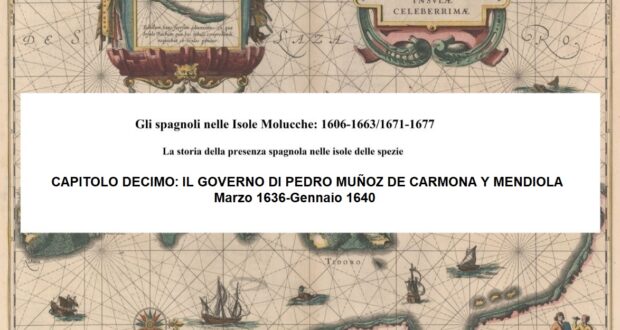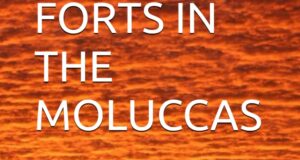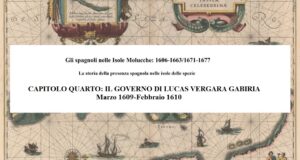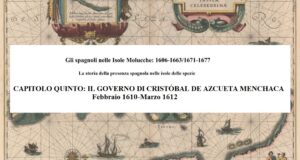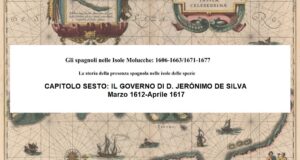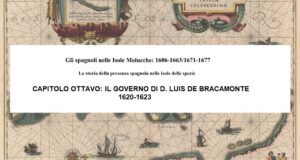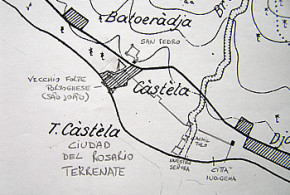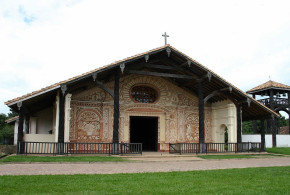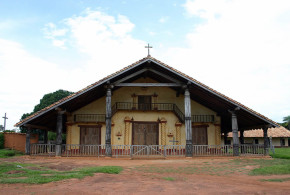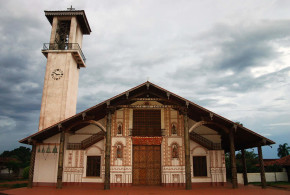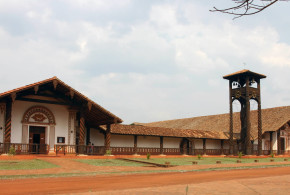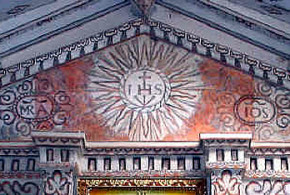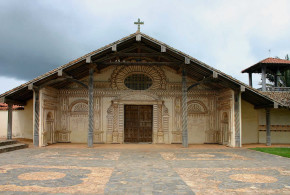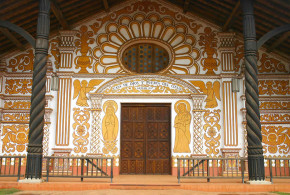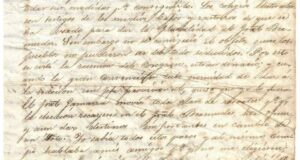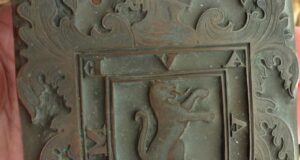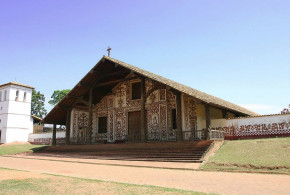This post is also available in:
![]() Italiano
Italiano
The Spaniards in the Moluccas: 1606-1663/1671-1677. The history of the Spanish presence in the spice islands
Written by Marco Ramerini. 2005-2020/23
CHAPTER TEN: THE GOVERNMENT OF PEDRO MUÑOZ DE CARMONA Y MENDIOLA, March 1636-January 1640
THE ARRIVAL OF PEDRO MUÑOZ DE CARMONA Y MENDIOLA IN TERNATE
The new governor of Ternate D. Pedro Muñoz de Carmona y Mendiola, appointed “alcayde”, governor and “castellan” of Ternate, departed from the port of Cavite on January 9, 1636. On board his ship was also a company of Spanish infantry. He arrived in Ternate on March 7, 1636 and ruled Ternate until January 22, 1640.1
THE COST OF THE GARRISIONS OF THE MOLUCCAS
The cost of fighting the Dutch and maintaining the Spanish garrisons of the Moluccas accounts for more than a third of all Philippine expenditure. Military expenses are the ones that have the greatest impact on the budget of the Moluccas, the castellan and governor of the Moluccas receives 2,750 pesos, the two adjutants of the sergeant major 850 pesos each. Then there are 7 companies of foot soldiers for a total of 570 soldiers. The captains of each company each receive 600 pesos. Each standard bearer 240 pesos, each sergeant 120 pesos, each corporal receives 30 pesos more than the normal soldiers’ pay. In addition, each company receives 30 scudos in addition to their normal pay. The total cost of each of these companies is 9,809 pesos.
In the garrisons of the Moluccas there are also two “Pampangos” infantry companies with 200 soldiers. Each captain receives 288 pesos, each ensign 192, each sergeant 144 and each foot soldier 72 pesos. These two infantry companies cost 13,312 pesos. In the garrison of Ternate on the payroll there is also a surgeon whose salary is 664 pesos, an artillery captain with a salary of 480 pesos, a “constable” with 300 pesos, a field captain 330 pesos, a notary of war 200 pesos, an accountant and factor 1,150 pesos, a chief clerk 400 pesos, another clerk 150 pesos, a notary of the royal treasury 250 pesos, an accountant and paymaster 523 pesos, 20 sailors 150 pesos and a “ganta” of rice for one, a “cura” 50,000 maravedis, a sacristan 25,000 maravedis and seven religious, 4 Franciscans and 3 Jesuits, to whom 1,330 pesos are given. The total amount of expenses of the Moluccas garrisons is 97,128 pesos, 3 reals.
The two captains of the two Ternate galleys each receive 699 and a half pesos. Each galley has a chief who receives 170 pesos, a master of the galleys who receives 300 pesos, a boatswain 250 pesos, a boatswain’s assistant 217 and a half pesos, an “alguaçil” 230 pesos, an oarmaker 230, 3 sailors each 133 pesos, finally there are the approximately 180 prisoners assigned to the galley who each receive 27 pesos and 2 reals as well as 3 pesos in clothes. The upkeep of each Ternate galley costs a total of about 7,500 pesos.2 The costs for the Ternate hospital amount to 1,000 pesos.3 The total cost that the crown of Spain has to bear for the maintenance of the Moluccas amounts to about 290,000 pesos.4
A NAVAL CLASH WITH THE DUTCH
In January 1637 (or during the year 1636 as it is reported in the Meritos of Pedro Fernandez del Rio) a new fleet of “socorro” was sent to Ternate it was composed of 2 large ships, a “patache” and a galley (in Corcuera’s letter two “pataccos” and no galleys are indicated5 and several6 large “champanos” in command was General Hieronimo Enriques Sotelo (Geronimo Henriquez) who was embarked on the San Luis galleon, while on the other galleon was Admiral Don Pedro de Altomonte (who had also participated in the previous year’s expedition), while in command of the “patache” was Don Alonso de Alcoçer. Finally, in command of the new galley “San Francisco Xavier” was Rafael Gomes.
Pedro Fernandez del Rio, who we will later find as governor of the Moluccas, will also participate in this “socorro”.. On board the ships were 200 Spanish foot soldiers and 200 sailors. Two Dutch ships which were at Ternate, and which were waiting for the Spanish fleet to attack it, at the sight of the large fleet, took refuge in the shelter of the cannons of their fortress of Malayo. After having landed the supplies, the Spanish ships attempted a sortie, the galleons and galleys attacked the Dutch and bombarded “desde las diez del dia hasta puesto el sol” both the fortress and the two Dutch shipsi7, the Spanish attack caused heavy damage to both the fort and the ships, in the clash the Spanish ship Almiranta, where Fernández del Rio was in charge of the artillery, suffered damage and the Spanish had a sailor killed. This action caused a huge impression among the inhabitants of the islands, even the king of Tidore congratulated General Hieronimo Enriques Sotelo (Geronimo Henriquez) and Admiral D. Pedro de Altomonte. Several Dutch soldiers deserted and took refuge in the Spanish fort, they will be sent to Manila with the two galleons. After this clash the two galleons and the patacco returned to Manila without however bringing cloves because there had been no harvest this year. In Ternate, however, the galley remained, which flanked the other galley already present in Ternate.
Shortly after the departure of the Spanish galleons, the two Dutch ships also put to sea, but during a calm wind they were promptly attacked by the two spanish galleys8 spagnole, during the engagement one of the ships was nearly overwhelmed, but a sudden increase in the wind allowed the two ships to disengage. News also arrives of an ongoing rebellion against the king of Manados, an ally of the Spaniards, who on this occasion asked the governor Mendiola for help. The sixteen-year-old or seventeen-year-old son of the king also arrived from Manados, sent to Ternate to be educated among the Spaniards, finally the king asked for friars to be sent to baptize his vassals. Promptly Mendiola sent the requested aid to Manados and the Jesuit Father Pantaleon was sent with them.9
At the end of October 1638, a champan brought good news from Ternate. In fact, Sergeant Major Francisco Hernandez had raided enemies with good results. He captured in Macasar (Manados), the Spanish soldiers who had deserted the year before together with Captain Ramos (who had later been killed during a quarrel between the deserters), they were arrested and sent to the galleys.
The two galleons of the “soccorro” of Ternate set sail on the night of 21 November 1638, the flag-bearer was the “San Luis”, while the flagship was the “San Juan”, the fleet commander was Don Pedro de Altomonte, while the admiral was Don Alonso de Alçocer, Pedro Fernández del Rio also participated in this expedition as captain and sergeant major, he was in charge of the expedition from Cavite to Zamboanga, where he ceded command to Don Pedro de Altomonte. The flagship ship will return, together with the patacco, from this expedition on April 18, 1639, while the ship Almiranta, which had lost contact with the other boats near the coast of the island of Celebes, returned on May 30.10 With the ships returning from Ternate also arrived 150 warriors from the island of Siao and 50 Christians from Ternate who took part in the wars on the island of Mindanao in 1639.11 The Franciscan friar Bartolomé de San Diego and his brother Miguel de San Buenaventura, preached (between 1630 and 1640) in the missions of Calonga and Tabuca, islands probably part of the archipelago of the Talud islands, located between Sulawesi and Mindanao.12
ALLIANCE BETWEEN TERNATE AND TIDORE
In the Moluccas, the kings of Ternate and Tidore made peace and formed an alliance. Governor Mendiola, worried by these events, sent to Manila to ask for help Father Manuel Carballo, rector of the Jesuit convent of Ternate, he arrived in Manila on August 11, 1639. The cause of this radical change of policy by the king of Tidore seems to be purely formal, in fact the reasons given by the king are linked to the failure to deliver, in the last 4 years, the traditional gift that the king of Spain sent every year through the governor of the Philippines to the king of Tidore. In any case, the rector believes that the king may have, in addition to these motivations, other unknown and therefore more dangerous motives. To resolve the matter, a new governor, Francisco de Figueroa, was sent to Ternate.13
In 1639, a boat sent to Ternate with several pieces of artillery on board was attacked by a violent storm, the ship was forced to return to the port of departure, where due to bad weather all the artillery was lost.14 On October 31, 1639, another boat from Ternate arrived in Manila, it brought bad news for the Spaniards. In fact, the old king of Tidore, the cachil Naro, had been killed by the Ternatese and Tidorese, helped by the Dutch, he had been deposed by Pedro de Heredia, but the king of Spain had ordered to reinstate him to power because he was considered more reliable and faithful of the present king of Tidore. For fear of rebellions, reinforcements were promptly sent to the islands, on November 5, 1639, the “soccorro” fleet left for the Moluccas, commanded by Captain Andres de Urbina the fleet was well stocked with men and provisions, the patacco “San Nicolas” was also sent the chief pilot was Captain Machado, moreover it seems that several galleys were sent.15
INDEX
1: The first contacts of the Spaniards with the Moluccas
2: The conquest of Ternate
3: The government of Juan de Esquivel, May 1606-March 1609
4: The government of Lucas de Vergara Gabiria (acting the functions), March 1609-February 1610
5: The government of Cristóbal de Azcueta Menchaca (who performs the duties), February 1610-March 1612
6: The government of D. Jerónimo de Silva, March 1612-April 1617
7: The government of Lucas de Vergara (Bergara) Gabiria (second term), April 1617-February 1620
8: The government of D. Luis de Bracamonte (who performs the functions), February 1620-1623
9: The government of Pedro de Heredia, 1623-1636
10: The government of D. Pedro Muñoz de Carmona y Mendiola (who performs the functions), March (?) 1636-January 1640
11: The last Spanish governors of the Moluccas
12: Bibliography
NOTES:
1 (AGI: “Informaciones, Pedro Muñoz de Carmona y Mendiola, 1649” Filipinas,61,N.26 f. a12, h9)
2 (“Memorial Grau y Montfalcon, 1637” In: Blair, E. H. e Robertson, J. A. “The Philippine Islands, 1493-1898” vol. 27 pp. 128-130)
3 (“Memorial Grau y Montfalcon, 1637” In: Blair, E. H. e Robertson, J. A. “The Philippine Islands, 1493-1898” vol. 27 p. 125)
4 (“Memorial Grau y Montfalcon, 1637” In: Blair, E. H. e Robertson, J. A. “The Philippine Islands, 1493-1898” vol. 27 pp. 139)
5 (“Letter by Corcuera to Felipe IV, 20 August 1637” In: Blair, E. H. e Robertson, J. A. “The Philippine Islands, 1493-1898” vol. 27 p. 348)
6 They are 6 according to (“Letter by Corcuera to Felipe IV, 20 August 1637” In: Blair, E. H. e Robertson, J. A. “The Philippine Islands, 1493-1898” vol. 27 p. 348)
7 Nei “Meritos: Pedro Fernández del Rio, 05-1647”, si parla di tre navi olandesi.
8 In command of the old galley was Don Agustin de Cepada.
9 (Pimpín, T. “Sucesos felices que por mar y tierra ha dado N.tro Señor a las armas Españolas en las Islas Filipinas contra el Mindanao y en las de Terrenate, contra los Holandeses por fin del año de 1636 y principio del de 1637” Published in: Rentana, W. E. “Archivo del bibliófilo filipino” Tomo IV pp. 134-136) (“Events in Filipinas, 1636-1637” In: Blair, E. H. e Robertson, J. A. “The Philippine Islands, 1493-1898” vol. 27 pp. 312-314) (“Letter from Corcuera to Felipe IV, August 20, 1637” In: Blair, E. H. e Robertson, J. A. “The Philippine Islands, 1493-1898” vol. 27 p. 348) (“Events in Filipinas, 1637-1638” In: Blair, E. H. e Robertson, J. A. “The Philippine Islands, 1493-1898” vol. 29 p. 32, 36) (AGI: “Meritos: Pedro Fernández del Rio, 05-1647” Indiferente,113,N.50)
10 (“Events in Filipinas, 1638-1639” In: Blair, E. H. e Robertson, J. A. “The Philippine Islands, 1493-1898” vol. 29 pp. 150-152, 158) (“Meritos: Pedro Fernández del Rio, 05-1647” A.G.I. Indiferente, 113, N.50)
11 (“Events in Filipinas, 1638-1639” In: Blair, E. H. e Robertson, J. A. “The Philippine Islands, 1493-1898” vol. 29 p. 158)
12 (“Early Franciscan Missions” In: Blair, E. H. e Robertson, J. A. “The Philippine Islands, 1493-1898” vol. 35 p. 309 e nota 90)
13 (“Events in Filipinas, agosto 1639- agosto 1640” In: Blair, E. H. e Robertson, J. A. “The Philippine Islands, 1493-1898” vol. 29 pp. 195-196)
14 (“Letter from Philip IV to Corcuera, August 4, 1643” In: Blair, E. H. e Robertson, J. A. “The Philippine Islands, 1493-1898” vol. 35 p. 166)
15 (“Events in Filipinas, agosto 1639- agosto 1640” In: Blair, E. H. e Robertson, J. A. “The Philippine Islands, 1493-1898” vol. 29 pp. 198-201)
This post is also available in:
![]() Italiano
Italiano
 Colonial Voyage The website dedicated to the Colonial History
Colonial Voyage The website dedicated to the Colonial History
